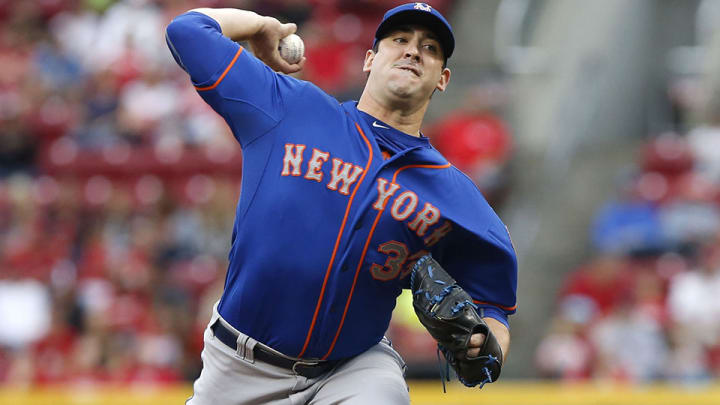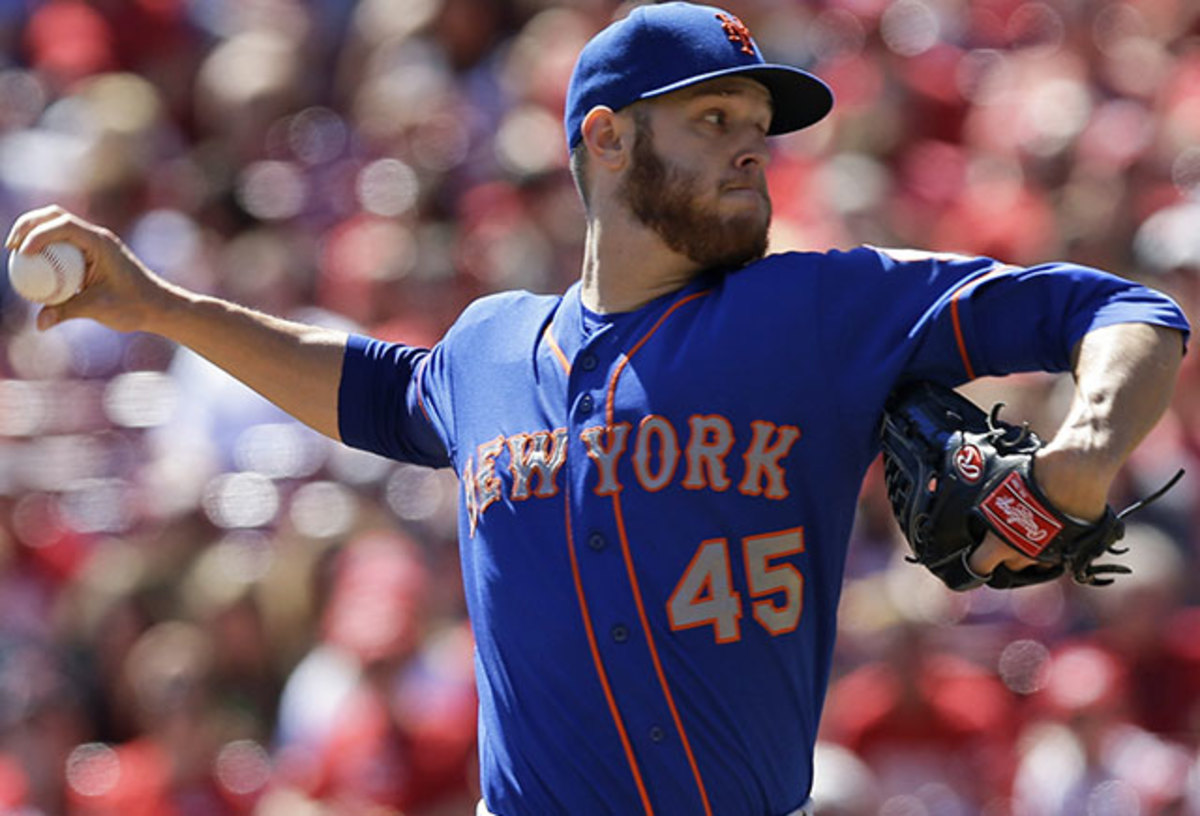2016 MLB season preview: New York Mets

This week, SI.com is previewing all 30 MLB teams for the 2016 season, counting down to the No. 1 team in the league. At No. 3: the New York Mets.
2015 Record and Finish:
90–72 (.556), first place in National League East (seventh overall); lost World Series to Royals
2016 Projected Record and Finish:
95–67 (.586), first place in NL East
The Case For
Four men will be the difference between the Mets repeating as NL East champions and making a run at their second straight World Series berth or spending October watching the playoffs from home: Matt Harvey, Jacob deGrom, Noah Syndergaard and Steven Matz. Thanks to the best rotation in baseball, New York pulled off its surprising division title and NL pennant in 2015, and that rotation will once again be the basis for the team's contention hopes this year.
The debate over which of those four pitchers has the best stuff or is the Mets’ true ace could go on all season, but in reality, it doesn’t matter. All four are legit top-of-the-rotation pitchers who boast elite velocity, control and command, and any team would be lucky to have any one of them, much less all four. Having that quartet gives the Mets a gigantic advantage—a group that will keep them in the playoff hunt almost regardless of what else happens. New York is also welcoming back former top prospect Zack Wheeler, who underwent Tommy John surgery in early 2015 and will likely join the team at midseason.
Luckily for the Mets, there are plenty of other positives on their roster beyond the starting five. The lineup is potent, particularly now that New York will get full seasons out of Cuban superstar Yoenis Cespedes, who was acquired in a July 31 trade with the Tigers and re-signed as a free-agent during the off-season, and highly productive rookie Michael Conforto, who made his major league debut one week before Cespedes arrived. Along with Curtis Granderson, who experienced a resurgence last season (a 125 OPS+, his highest mark since 2011), they give the Mets one of the NL’s best outfields. Travis d’Arnaud is one of the league’s better-hitting catchers, and first baseman Lucas Duda and second baseman Neil Walker (acquired this winter for reserve starter Jonathon Niese) provide plenty of power on the right side of the infield.
A healthy season from David Wright would help give that lineup more punch as well. Wright was limited to 38 games last season because of a hamstring injury and a degenerative spinal condition, but he was able to come back in time for the stretch run and the postseason and put up solid production (.277/.381/.437 from Aug. 24 onward). Should he return in form, then New York will be able to put out a batting order with all nine hitters likely producing at league average or better—a far cry from the hopeless group that slept walk through the first half of last season.
The Case Against
For as strong as New York’s rotation is, the heavy workloads logged by the top trio of Harvey, deGrom and Syndergaard in the pursuit of a championship are worrisome. Harvey, coming off 2013 Tommy John surgery, blew past his Scott Boras-suggested innings limit of 180 to throw 216 last year between the regular season and playoffs. Syndergaard and deGrom, meanwhile, both set career highs in innings (the former with 169 in the regular and postseasons, the latter with 216), and by wide margins, too. Matz is the lone youngster of the group who didn’t go above and beyond his previous limits—but that’s only because a string of injuries kept him from doing so.
The addition of Wheeler and the presence of veteran stalwart Bartolo Colon should help Terry Collins manage his starters’ innings, but there’s no doubt that, to reach the postseason again, the Mets will have to lean on their top four. A thin bullpen won’t help matters. Closer Jeurys Familia is an ace in the ninth inning, but Collins was forced to call on him often throughout the season and especially in the playoffs, possibly decreasing his effectiveness this year. Worse, there are few other pitchers Collins can trust in his relief corps. Off-season addition Antonio Bastardo is a quality arm, but the losses of Jenrry Mejia and Tyler Clippard leave the Mets lacking an impact righthander. All of that will force Collins to ask a lot of his young starters and Familia, which could leave them exhausted by the time October rolls around.
As for the lineup, the injury-prone ways of Wright, d’Arnaud and Duda could create some serious depth issues if any of them is forced to miss a substantial amount of time. Already, New York is dealing with the absence of Asdrubal Cabrera at shortstop—something exacerbated by the front office’s parsimonious decision to release slick-fielding infielder Ruben Tejada in the middle of spring training. Perhaps more than any other team, the Mets need their stars to stay healthy.
• MORE MLB: NL breakout candidates | NL busts | NL rookies to watch

X-Factor: Zack Wheeler, SP
It’s almost unfair that a team with Harvey, deGrom, Syndergaard and Matz should get to add a fifth top starter to its rotation. But that’s where the Mets will likely find themselves in the summer when Wheeler makes his return. His loss in spring training last year was a potential disaster, but the emergence of Syndergaard and Matz helped paper over his injury. New York came close to giving up Wheeler for good last July in the aborted trade that would have sent him and Wilmer Flores to the Brewers for Carlos Gomez—one called off at the last minute because of the Mets’ concerns over Gomez’s health. Instead, the team got Cespedes and made its run, and now it gets to have Wheeler as a potential impact addition in the second half.
Before blowing out his elbow, Wheeler showed terrific velocity (averaging 95 mph on his four-seam fastball) and outstanding swing-and-miss stuff (9.08 strikeouts per nine and a swinging-strike rate of 10%) in 2014. One potential issue was his shaky command: He averaged 3.84 walks per nine in that last healthy season, and control often takes some time for Tommy John recipients to regain. On top of that, New York will likely want to be cautious with him the way it was with Harvey. One possibility: Turning to a six-man rotation, which the Mets briefly experimented with last season when Matz was called up. That could help keep the innings down for all of the team’s important young arms and still let New York reap the benefits of having five elite pitchers. All of that is contingent on Wheeler coming back healthy, but if he can, the already-pitching-rich Mets will get even richer.
Number To Know: 69
That’s how many games d’Arnaud has averaged in his first three seasons with the Mets, largely due to injury (aside from his rookie year in 2013, when he played in 31 games after being called up in August). In 2014, he managed just 108 games thanks to a concussion and right elbow soreness; last year, a left elbow sprain and a fractured right pinkie finger limited him to 67 contests. The 27-year-old catcher’s injury history is problematic, to say the least: To that litany of ailments at the major league level, you can add a left knee sprain and left foot fracture suffered in the minors. And while d’Arnaud has avoided injury so far this spring, it feels like only a matter of time before he gets hurt again.
The Mets are making an effort to do what they can to reduce d’Arnaud’s exposure to injury, including talk of having him play first base and the outfield, and of having rookie Kevin Plawecki take more time behind the plate. Whether or not putting d’Arnaud in unfamiliar situations or handing additional at-bats to Plawecki (.219/.280/.296 in 258 plate appearances for the Mets last year as a 24-year-old) are good ideas remain to be seen. But doing what it takes to keep d’Arnaud healthy and on the field is a good call on New York’s part. When able, d’Arnaud has shown game-changing offensive ability—he posted a 128 OPS+ in limited action last year—and strong skills behind the plate. Catcher has been a revolving door for the Mets since the last days of Mike Piazza; d’Arnaud could be the rock behind the plate that New York has been searching for at the position for a decade, but only if he can avoid the injury bug that has marked his career to date.
The SI Extra Newsletter Get the best of Sports Illustrated delivered right to your inbox
Subscribe
Scout’s Takes
Most Overrated: Yoenis Cespedes, OF
“I think they could have been okay without him. I wonder if at some point the players there get tired of the first six or eight days of spring training, a different $100,000 car every day … the whole Yoenis Cespedes show.”
Most Underrated: Travis d'Arnaud, C
“The value he brings of handling those four pitchers, how well he does that, calling the games, leads to a lot of their success. He also can do a little bit of damage offensively.”
